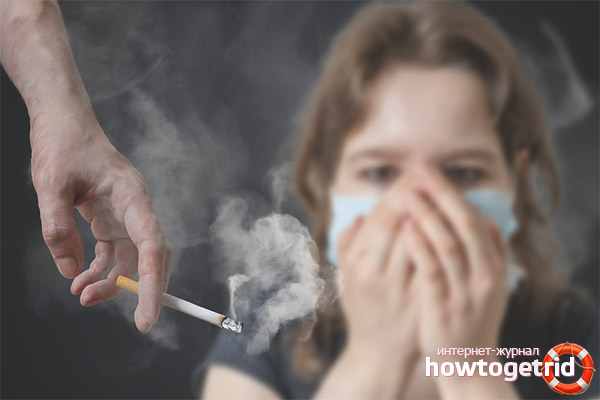The content of the article
Tobacco smoke, unfortunately, contains not only nicotine, but many other harmful substances. Wrong is the one who believes that the harmful effects of tobacco is determined only by nicotine. Of course, nicotine, as a poison of a neurogenic nature, bears a tremendous harm to the body. But do not forget that it contains more than 4 thousand toxic substances that in different degrees have a harmful effect on the body. No wonder they say that smoking a cigarette is equivalent to a person breathing car exhausts. The point of application of all these poisons is the cellular level at which they cause irreversible destructive changes.
Sad statistics
Among the women of our country, each of 11-12 women smokes.Among men, 58% of men with cigarettes are friends. And the experience of the inveterate smoker is far rather big in its duration. The addiction haunts him for 15-20 years of life.
Naturally, an irreconcilable struggle at the state level is being waged with this phenomenon. Advertising of cigarettes is prohibited, age for their sale is limited. In some places, smoking is prohibited at all. Anti-tobacco advertising is widely used, including cigarette packs.
This is done by chance. This social evil is the cause of high mortality from diseases caused by the entry of tobacco smoke into the body. These statistics speak for themselves:
- The annual mortality rate due to smoking is more than 450 thousand people.
- Smokers have a high probability of death at the age of 40-45 years.
- In the working-age population, every fifth person suffers from a disease caused by smoking.
The similar problem is characteristic not only for our country, but also for the whole world. It is hard to imagine, but every 5 seconds one person dies from smoking in the world.
Smoking causes hypoxia
Tobacco smoke selectively acts on the respiratory system. With an increase in the length of service, smoking gradually forms a condition called hypoxia. Its main manifestation is the lack of oxygen with all the ensuing consequences. When smoking, the body does not receive oxygen, but carbon monoxide.
Schematically, the process of tissue respiration can be represented as follows:
- When oxygen enters along with the inhaled air, it is bound to the hemoglobin of the blood. As a result, a compound is formed that is called oxyhemoglobin.
- Due to the transport function of blood, various tissues are the final point of its delivery.
- Once oxyhemoglobin reaches its destination, it undergoes decay. This releases the oxygen in it.
The replacement of oxygen by carbon monoxide leads to the fact that instead of oxyhemoglobin, carboxyhemoglobin is formed - a substance extremely harmful to the body. Carbon monoxide combines with hemoglobin three hundred times faster than oxygen.At the same time, its disintegration is much slower, and, therefore, it has a longer harmful effect.
The formation of carboxyhemoglobin leads to chronic lack of oxygen. Hypoxia forms a symptom such as shortness of breath. Initially, it can manifest itself during physical exertion, then it can be observed at rest. Important organs instead of oxygen get carbon monoxide. Naturally, this causes the suffering of their function.
The process of urbanization has led to a deterioration in the qualitative composition of the atmosphere of large cities. This phenomenon is inevitable and is one of the components of the process of scientific and technical progress. For everything in life you have to pay. Even if a resident of a large city does not smoke at all, then his blood contains carbon monoxide (CO) in the amount of 0.92%. It is worth smoking only one cigarette, as this amount will increase 6 times.
If smoking is intense, the content of carboxyhemoglobin in the blood reaches 18%. If this figure reaches 20%, symptoms arise from impaired brain function. A heavy smoker is familiar with these symptoms:
- There are dyspeptic symptoms, the smoker is often nausea.
- There is a headache.
- There may be bouts of dry cough with pain in the chest.
- The heart starts beating much more often.
- The pressure rises, a feeling of pulsation is noted in the temples.
Passive smoker
When a cigarette is smoked, not all tobacco smoke gets into the smoker’s lungs, but only 20% of its quantity. The remaining 80% are in the room or the surrounding atmosphere. It is not necessary to smoke a cigarette yourself. One has only to breathe this smoke and become a passive smoker. But a person inhales into the body all the same harmful substances as the one that does not release a cigarette from his mouth.
It is no coincidence that much attention is paid to issues of passive smoking. If there is at least one smoker in the family, other members can already detect nicotine content in various biological environments. This includes blood, urine, saliva, and other substrates. In passive smoking, the nicotine content in them can reach up to 2%.
As a result of passive smoking, there is a decrease in the working volume of the lungs to 10%. Atherosclerotic processes begin to flow more intensively. This entails the emergence of a number of undesirable states:
- Infant mortality increases in infancy.
- Cases of fertility of children with underweight are increasing.
Cancer incidence is growing rapidly:
- women have breast cancer;
- increases the risk of brain cancer in childhood;
- diseases of bronchial asthma become a frequent satellite.
Destructive processes in the brain are developing intensively, and senile dementia in people over 50 years of age becomes the result.
Cardiovascular pathology
As a result of smoking, there are processes leading to an increase in blood viscosity. This entails an increased risk of blood clots. And this is the cause of heart attacks. In order to push the smoker's viscous blood through the vessels, the heart is forced to work with greater intensity. It speeds up its contractions, hence a pronounced tachycardia. During ischemia of the heart, the left ventricle is hypertrophied, peripheral arterial pressure increases.
Heart palpitations are also due to the fact that tobacco smoke triggers a surge of adrenaline and dopamine into the bloodstream.Of course, the heart is only a muscle, not an iron ingot, and wears out quickly. It can not work for a long time with a large load. Sooner or later, it openly declares itself.
A smoker has pains of varying intensity in heart projection. Sometimes pains are piercing in nature as a dagger pain. The heart works with an accelerated frequency. All these phenomena are due to hypoxia, which develops due to the presence of carboxyhemoglobin, which is formed under the influence of tobacco smoke.
Vascular apparatus
Under the influence of carboxyhemoglobin, arteries are in a state of constant spasm. In addition, nicotine is a powerful vascular poison. It selectively acts on the endothelial tissue, which the vessels are so rich in. This leads to deposition in the vessel wall and its lumen of plaques of atherosclerotic origin. In other words, atherosclerosis becomes apparent.
The blood of a smoking person is richly saturated with prostaglandins, and they are known to be inflammatory factors. They further intensify atherosclerotic phenomena.
Smoking, as a factor in the development of atherosclerosis, leads to the following phenomena in the body:
- The pressure associated with kidney damage (hypertension of a renovascular nature) increases.
- Affected brain arteries carry the risk of ischemic type stroke.
- Heart vessels are destroyed, which leads to the development of angina stress.
Under the influence of nicotine, the atherosclerotic plaque can rupture. As a result, its content enters the lumen of the vessel and can block it. This area does not receive the required amount of blood, and with it oxygen, undergoing the phenomena of necrosis. In other words, a heart attack develops.
Nicotine does not disregard peripheral blood vessels. Often it is the cause of the development of obliterating endarteritis. Smokers have a persistent constriction of the vessels in the area of the feet. The main symptom of this disease is intermittent claudication. The result is sad and consists in the development of gangrene and amputation of the foot.
Skin, sensory organs, brain
There is not a single organ in the human body that does not suffer from the action of nicotine.
Organ of vision
Nicotine significantly affects its function:
- Perhaps the development of angiopathy of the retina. This is due to insufficient blood supply. In addition, small vessels are constantly in a state of spasm.
- It is quite possible the occurrence of tobacco amblyopia. It can be observed, including, and with passive smoking.
- Formation of eye cataracts.
- The presence of allergic conjunctivitis.
Organ of hearing
Nicotine does not remain without attention and this important organ for humans:
- Under the influence of smoking occurs and development of sensorineural hearing loss.
- There is a deterioration in the ability to perceive speech.
Leather
Nicotine has a pronounced effect on the skin and skin appendages:
- Due to insufficient blood supply, the skin becomes dry, its elasticity is lost, which leads to the early appearance of wrinkles.
- The face gets a gray tint.
- Hair loses its stability, and there is a tendency to their loss. In addition, they lose their luster, pomp, begin to break.
Tooth tissue
Smoker provokes the appearance of changes in the structure of dental tissue:
- It becomes yellow color of the teeth.
- Gums lose their health. Their bleeding may appear.
- Teeth may fall out. Approximately half of smokers at the age of 40 lose all natural teeth.
central nervous system
Brain tissue is very sensitive to the effects of nicotine. Smoking can cause a variety of negative conditions:
- Sleep disturbance and the formation of persistent insomnia.
- The appearance of headaches.
- The development of atherosclerotic phenomena in the brain tissue.
- Increased risk of intracranial hemorrhage.
- The risk of developing oncological pathology of brain structures increases.
Reproductive function
Smoking contributes to the development of infertility. Among female smokers, 42% of women are affected. Increases the likelihood of miscarriages. Under the influence of nicotine, the quality of the egg decreases. Reduces the period of reproductive function. In men, smoking is one of the main reasons for the development of erectile dysfunction. Nicotine also affects the quality of the seed stock.
In conclusion, it should be said that smoking is a social evil. Nicotine affects literally every cell in our body. This addiction can and must be fought. The smoker should make a choice in favor of abandoning this habit. Having gathered the will into a fist, it is quite possible to abandon it. Otherwise, then it will be just late.
Video: how smoking affects the human body











To send